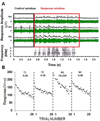He hears, she hears: are there sex differences in auditory processing?
- PMID: 25220950
- PMCID: PMC4324369
- DOI: 10.1002/dneu.22231
He hears, she hears: are there sex differences in auditory processing?
Abstract
Songbirds learn individually unique songs through vocal imitation and use them in courtship and territorial displays. Previous work has identified a forebrain auditory area, the caudomedial nidopallium (NCM), that appears specialized for discriminating and remembering conspecific vocalizations. In zebra finches (ZFs), only males produce learned vocalizations, but both sexes process these and other signals. This study assessed sex differences in auditory processing by recording extracellular multiunit activity at multiple sites within NCM. Juvenile female ZFs (n = 46) were reared in individual isolation and artificially tutored with song. In adulthood, songs were played back to assess auditory responses, stimulus-specific adaptation, neural bias for conspecific song, and memory for the tutor's song, as well as recently heard songs. In a subset of females (n = 36), estradiol (E2) levels were manipulated to test the contribution of E2, known to be synthesized in the brain, to auditory responses. Untreated females (n = 10) showed significant differences in response magnitude and stimulus-specific adaptation compared to males reared in the same paradigm (n = 9). In hormone-manipulated females, E2 augmentation facilitated the memory for recently heard songs in adulthood, but neither E2 augmentation (n = 15) nor E2 synthesis blockade (n = 9) affected tutor song memory or the neural bias for conspecific song. The results demonstrate subtle sex differences in processing communication signals, and show that E2 levels in female songbirds can affect the memory for songs of potential suitors, thus contributing to the process of mate selection. The results also have potential relevance to clinical interventions that manipulate E2 in human patients.
Keywords: estradiol; learning; memory; sex differences; zebra finch.
© 2014 Wiley Periodicals, Inc.
Conflict of interest statement
Figures








References
-
- Bell BA, Phan ML, Vicario DS. Auditory responses in the songbird forebrain reflect acquired salience and individual learning rates in a behavioral discrimination paradigm. Abstract, Society for Neuroscience. 2013 196.20/KKK31.
-
- Burgess LH, Handa RJ. Chronic, estrogen-induced alterations in adrenocoticotropin and corticosterone secretion, and glucocorticoid receptor-mediated functions in female rats. Endocrinology. 1992;131:1261–1269. - PubMed
Publication types
MeSH terms
Substances
Grants and funding
LinkOut - more resources
Full Text Sources
Other Literature Sources

